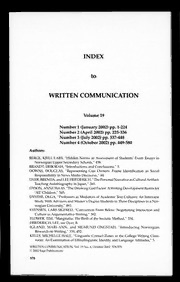
Written Communication 2002: Vol 19 Index PDF
Preview Written Communication 2002: Vol 19 Index
to WRITTEN COMMUNICATION Volume 19 Number 1 (January 2002) pp. 1-224 Number 2 (April 2002) pp. 225-336 Number 3 (July 2002) pp. 337-448 Number 4 (October 2002) pp. 449-580 Authors: BERGE, KJELL LARS, “Hidden Norms in Assessment of Students’ Exam Essays in Norwegian Upper Secondary Schools,” 458. BRANDT, DEBORAH, “Introductions and Conclusions,” 3. DOWNS, DOUGLAS, “Representing Gun Owners: Frame Identification as Social Responsibility in News Media Discourse,” 44. DYER, BRENDA, and LEE FRIEDERICH, “The Personal Narrative as Cultural Artifact: Teaching Autobiography in Japan,” 265. DYSON, ANNE HAAS, “The Drinking God Factor: A Writing Development Remix for ‘All’ Children,” 545. DYSTHE, OLGA, “Professors as Mediators of Academic Text Cultures: An Interview Study With Advisors and Master’s Degree Students in Three Disciplines in a Nor- wegian University,” 493. EVENSEN, LARS SIGFRED, “Convention From Below: Negotiating Interaction and Culture in Argumentative Writing,” 382. FLOWER, TIM, “Marginalia: The Birth of the Socratic Method,” 334. FRIEDERICH, LEE, see Dyer, B. IGLAND, MARI-ANN, and SIGMUND ONGSTAD, “Introducing Norwegian Research on Writing,” 339, 452. KELLS, MICHELLE HALL, “Linguistic Contact Zones in the College Writing Class- room: An Examination of Ethnolinguistic Identity and Language Attitudes,” 5. WRITTEN COMMUNICATION, Vol. 19 No. 4, October 2002 578-579 © 2002 Sage Publications 578 to WRITTEN COMMUNICATION Volume 19 Number 1 (January 2002) pp. 1-224 Number 2 (April 2002) pp. 225-336 Number 3 (July 2002) pp. 337-448 Number 4 (October 2002) pp. 449-580 Authors: BERGE, KJELL LARS, “Hidden Norms in Assessment of Students’ Exam Essays in Norwegian Upper Secondary Schools,” 458. BRANDT, DEBORAH, “Introductions and Conclusions,” 3. DOWNS, DOUGLAS, “Representing Gun Owners: Frame Identification as Social Responsibility in News Media Discourse,” 44. DYER, BRENDA, and LEE FRIEDERICH, “The Personal Narrative as Cultural Artifact: Teaching Autobiography in Japan,” 265. DYSON, ANNE HAAS, “The Drinking God Factor: A Writing Development Remix for ‘All’ Children,” 545. DYSTHE, OLGA, “Professors as Mediators of Academic Text Cultures: An Interview Study With Advisors and Master’s Degree Students in Three Disciplines in a Nor- wegian University,” 493. EVENSEN, LARS SIGFRED, “Convention From Below: Negotiating Interaction and Culture in Argumentative Writing,” 382. FLOWER, TIM, “Marginalia: The Birth of the Socratic Method,” 334. FRIEDERICH, LEE, see Dyer, B. IGLAND, MARI-ANN, and SIGMUND ONGSTAD, “Introducing Norwegian Research on Writing,” 339, 452. KELLS, MICHELLE HALL, “Linguistic Contact Zones in the College Writing Class- room: An Examination of Ethnolinguistic Identity and Language Attitudes,” 5. WRITTEN COMMUNICATION, Vol. 19 No. 4, October 2002 578-579 © 2002 Sage Publications 578 Index 579 LUNSFORD, KAREN J., “Contextualizing Toulmin’s Model in the Writing Classroom: A Case Study,” 109. ONGSTAD, SIGMUND, “Positioning Early Research on Writing in Norway,” 345. ONGSTAD, SIGMUND, see Igland, M. SMIDT, JON, “Double Histories in Multivocal Classrooms: Notes Toward an Ecological Account of Writing,” 414. SWAN, SUSAN, “Rhetoric, Service, and Social Justice,” 76. VANDE KOPPLE, WILLIAM J., “From the Dynamic Style to the Synoptic Style in Spec- troscopic Articles in the Physical Review: Beginnings and 1980,” 227. WILDER, LAURA, “Get Comfortable With Uncertainty”: A Study of the Conventional Values of Literary Analysis in an Undergraduate Literature Course,” 175. WOLFE, JOANNA, “Marginal Pedagogy: How Annotated Texts Affect a Writing- From-Sources Task,” 297. Articles: “Contextualizing Toulmin’s Model in the Writing Classroom: A Case Study,” Lunsford, 109. “Convention From Below: Negotiating Interaction and Culture in Argumentative Writing,” Evensen, 382. “Double Histories in Multivocal Classrooms: Notes Toward an Ecological Account of Writing,” Smidt, 414. “The Drinking God Factor: A Writing Development Remix for ‘All’ Children,” Dyson, 545. “From the Dynamic Style to the Synoptic Style in Spectroscopic Articles in the Physical Review: Beginnings and 1980,” Vande Kopple, 227. “ ‘Get Comfortable With Uncertainty’: A Study of the Conventional Values of Literary Analysis in an Undergraduate Literature Course,” Wilder, 175. “Hidden Norms in Assessment of Students’ Exam Essays in Norwegian Upper Second- ary Schools,” Berge, 458. “Introducing Norwegian Research on Writing,” [gland and Ongstad, 339, 452. “Introductions and Conclusions,” Brandt, 3. “Linguistic Contact Zones in the College Writing Classroom: An Examination of Ethnolinguistic Identity and Language Attitudes,” Kells, 5. “Marginal Pedagogy: How Annotated Texts Affect a Writing-From-Sources Task,” Wolfe, 297. “Marginalia: The Birth of the Socratic Method,” Flower, 334. “The Personal Narrative as Cultural Artifact: Teaching Autobiography in Japan,” Dyer and Friederich, 265. “Positioning Early Research on Writing in Norway,” Ongstad, 345. “Professors as Mediators of Academic Text Cultures: An Interview Study With Advi- sors and Master’s Degree Students in Three Disciplines in a Norwegian Univer- sity,” Dysthe, 493. “Representing Gun Owners: Frame Identification as Social Responsibility in News Media Discourse,” Downs, 44. “Rhetoric, Service, and Social Justice,” Swan, 76.
